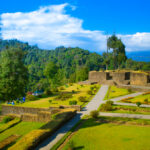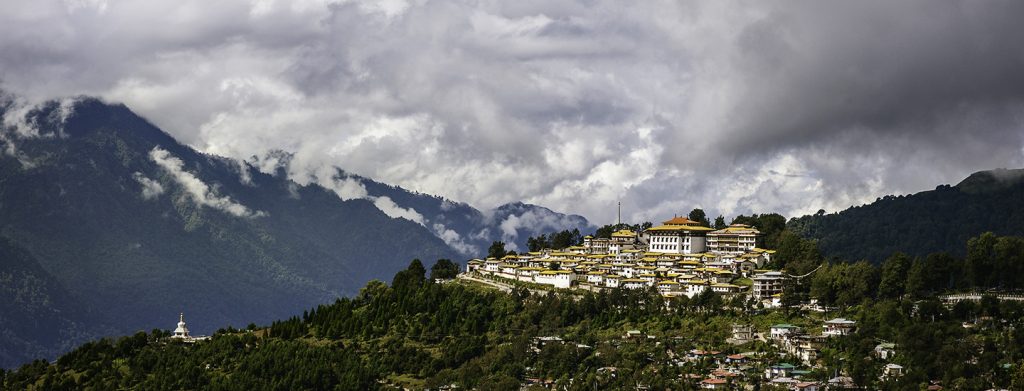Now Reading: Top 5 Best Places Visiting in Upper Siang for Nature, Culture & Adventure
-
01
Top 5 Best Places Visiting in Upper Siang for Nature, Culture & Adventure

Top 5 Best Places Visiting in Upper Siang for Nature, Culture & Adventure
1. Mariyang – Pekimodi Circuit
The migration destinations of Padam Pasi and Millang communities exist in Mariyang which traces 52 kilometers away from Yingkiong. This location remains accessible through the Pasighat – Ranaghat road after commuters make a river Siang boat crossing. The location sits on top of a hill to view the merger point between the rivers Yammeng and Yamne. Visitors going to Mariyang have the opportunity to visit Damro village because it holds the title of largest settlement in Upper Siang district at 10 Kms distance from the town.
The traditional Adi legend place Pekimodi rests 34 KMs distant from Mariyang. Traditional cultural heritage exists in large numbers among the Padams Millangs and Pasis people. During September the people of the area organize Solung as their main festival. A traditional performance called Ponung serves as the centerpiece of this festival that the local women conduct.
- Where to stay? :- Inspection Bungalow (IB) at Mariyang.
- Best time for visit :- All round the year.
- Main tourist destinations of this location include scenic scenery along with trekking activities and angling opportunities as well as spots for picnics.
2. Tuting – Gelling Circuit
Gelling represents the concluding Circle HQ because it holds a location along the International Boundary of China. The circle is marked by the historic MacMohan Line boundary region. It is 34 KMs from Tuting. The British Border Road Task Force converted half of the road into an all weather surface while the remaining section will be accessible by foot. The river Tsangpo enters Tibet at this point before it receives its local name Tsang Chu then transforms to Siang in the Southern area and Brahmaputra in Assam.
The Nyingma Sect under the Mahayana Buddhist tradition maintains control over Memba which belongs to the Gelling Cricle region. The Memba’s main religious festivities include Lossar, Torgya, Dhruba and Tsobum. The local community observes these festivals based on Buddhist religious traditions. BARDOH CHAAM commonly called Mask Dance takes place throughout the Buddhist festivals at all Gonpas. During dancing performances dancers choose to wear animal face masks. Through this dance the main message revolves around demonstrating both victory of good over bad and showcasing the value of animal protection.
Taking three hours to walk from Gelling to Bishing allows travelers to witness stunning waterfall cascades flowing more than 300 feet from above the mountain. Tourists can still observe the vestiges of Kapangla Pass by visiting Gelling. This pass controlled all commercial movements between Tibet and Adis as their commercial route in the past.
- Where to stay? :- Inspection Bungalow (IB) at Gelling.
- Best time for visit :- September to February.
- Main tourist attraction :-
- Dampo Tso lake near Gelling
- Sibe-Re waterfall at Bishing
- Kapangla Pass
- Trekking and scenery.
3.Riutala Circuit
The territory of Simong controls Ekodumbing (Riutala). Group members of Simong come to this site during October and November to gather EMO (Aconite) which serves as hunting material. PeDE together with the local species TANE and SIKO (all names in local dialect) can be observed in this region whereas Takins and Muskdeer (Sikung) are among the rare species that live here. Furthermore this area contains NYODO (Coptis tita) medicinal plant and TALAP (wild garlic) as well as other plant species.
Religious importance for Buddhists now drives many believers to visit this site. The people of Eko Dumbing identify this place as Riutala and they see it as the AWALOKESHWARA paradise that should be recognized as the CHENRISI paradise led by the Dalai Lama. Eko Dumbing is reached by following two trekking routes depending on the chosen route with durations of three days through Simong village and six days along Tuting – Tashigaon to Singha. A large number of Buddhists from distant territories come to this site between August and September to perform their devotional rituals. The mountains around this area host numerous lakes. Four watercourses known as Yammeng Simong Patang and Tangam Patang originated from River Sipit. A large number of caves around this site offer protection to visiting pilgrims. Every visitor who sets eyes on Eko-Dumbing is captivated by its stunning natural landscapes.
Transit to this site is possible by trekking through Simong in three days or Tuting in seven days.
Best time for visit:- August to November.
The main sights for visitors in this area comprise Sipit Lake and Yammeng Lake together with Komji Lipik (Caves), Simong and Tangam Patang caves.
4. Dewakota Circuit
The circuit leads from Yingkiong into Ekodumbing and terminates at Riutala.
The territory of Simong controls Ekodumbing (Riutala). Group members of Simong come to this site during October and November to gather EMO (Aconite) which serves as hunting material. PeDE together with the local species TANE and SIKO (all names in local dialect) can be observed in this region whereas Takins and Muskdeer (Sikung) are among the rare species that live here. Furthermore this area contains NYODO (Coptis tita) medicinal plant and TALAP (wild garlic) as well as other plant species.
Religious importance for Buddhists now drives many believers to visit this site. The people of Eko Dumbing identify this place as Riutala and they see it as the AWALOKESHWARA paradise that should be recognized as the CHENRISI paradise led by the Dalai Lama. Eko Dumbing is reached by following two trekking routes depending on the chosen route with durations of three days through Simong village and six days along Tuting – Tashigaon to Singha. A large number of Buddhists from distant territories come to this site between August and September to perform their devotional rituals. The mountains around this area host numerous lakes. Four watercourses known as Yammeng Simong Patang and Tangam Patang originated from River Sipit. A large number of caves around this site offer protection to visiting pilgrims. Every visitor who sets eyes on Eko-Dumbing is captivated by its stunning natural landscapes.
Transit to this site is possible by trekking through Simong in three days or Tuting in seven days.
Best time for visit:- August to November.
The main sights for visitors in this area comprise Sipit Lake and Yammeng Lake together with Komji Lipik (Caves), Simong and Tangam Patang caves.
5. Mouling National Wildlife Sanctuary
Mouling National Park received establishment in 1982 to develop a conducive environment for species and vegetation. Approximately 483 sq. km exists within the right bank of river Siang. The area provides a sanctuary for numerous species of plants together with animals. The area exhibits vegetation that changes based on the altitude range. Both the upper parts of the region harbor temperate alpine and coniferous forests and the base region maintains tropical evergreen woodland. The region is rich with both orchids and foxtail plants among the numerous ornamental species.
The park displays an excellent collection of animal and bird species. Endangered species including takins and snowclouded leopard along with golden languor and hornbill and monal scalater and serrow have been seen at the habitat. Managers have yet to identify many more species that exist in the region. Visitors can explore this park through winter paths beginning at Bomdo and Ramsing villages.
Many enchanting waterfalls exists within the protective area. Dabung Waterfall together with Nirbung Waterfall are among the most noteworthy waterfall attractions. Dogume Wildlife Sanctuary offers everything dreamlike to explorers who also love spotting animal and bird species.
Accomodation:- Jengging Circuit House, Forest Rest House at Ramsing.
What to see?:- Rare birds, animals, orchids, waterfalls, etc.
Best season for visit:- October to 1st week of January.
Related articles : https://travelinginfoworld.com/best-places-to-visit-in-tawang-valley/
Stay Informed With the Latest & Most Important News
Previous Post
Next Post
-
 01Top 5 Best Places Visiting in Gyalshing – Monasteries, Lakes & Scenic Escapes
01Top 5 Best Places Visiting in Gyalshing – Monasteries, Lakes & Scenic Escapes -
 02Top 5 Best Places Visiting in Panna – Temples, Waterfalls & Wildlife Escapes
02Top 5 Best Places Visiting in Panna – Temples, Waterfalls & Wildlife Escapes -
 03Top 2 Best Places Visiting in Chitradurga for History, Nature & Adventure
03Top 2 Best Places Visiting in Chitradurga for History, Nature & Adventure -
 04Top 10 Best Places Visiting in Dakshina Kannad for Culture, Nature & Coastal Charm
04Top 10 Best Places Visiting in Dakshina Kannad for Culture, Nature & Coastal Charm -
 05Top 5 Best Places to Visit in Malerkotla – Malerkotla Fort, Sheesh Mahal & More
05Top 5 Best Places to Visit in Malerkotla – Malerkotla Fort, Sheesh Mahal & More -
 06Best Places Visiting in Shopian – Explore Top Attractions & Hidden Gems
06Best Places Visiting in Shopian – Explore Top Attractions & Hidden Gems -
 07Top 10 Best Places to Visit in Sindhudurg for Beaches, Forts & Nature
07Top 10 Best Places to Visit in Sindhudurg for Beaches, Forts & Nature














Pingback: Top 6 Best Places Visiting in Barpeta – Explore Assam's Hidden Gem